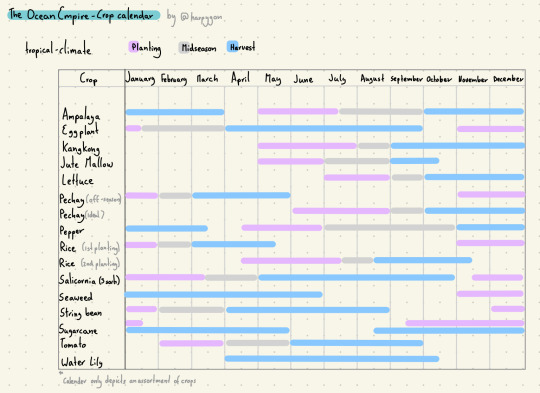#Salicornia brachiata
Explore tagged Tumblr posts
Photo

Salicornia brachiata
Umari Keerai
(via)
#Salicornia brachiata#Salicornia#succulent#halophyte#salt water plant#Umari Keerai#yellow#extremophile#edible#salty
72 notes
·
View notes
Text
Ocean Empire Crop Calendar

[Grimlands] [House Blossom] [Gilded Helianthia]
detailed thoughts (and information about crops depicted) under the cut
Jute Mallow isalso known as „bitter melon“ „bitter apple“ „bitter squash“ and bcountries specified as lying in the tropical zone (dependent on the list there might be more or less), I chose to look at the south-east Asian countries of Indonesia, Malaysia and the Philippines, the last being my main point of comparison.
The problem with the ocean empire is that it seems to have extremely limited planting ground (not taking into account soil under the ocean), meaning that most crops aren't really plantable.
In the beginning, I thought this was it, the ocean empire would have to live off fish, seafood and seaweed, but then I found hope.
This article talked about salt water rice, and while this example is made through human gene mutation, I'll assume that it naturally exists in the ocean empire.
Furthermore, we see lily pads being used a lot in the ocean empire, which his helpful, as (almost) the entirety of it is edible. Not only that, but the seeds can be ground into flour, meaning we have more options for filling foods such as bread. (There are no regular planting or harvesting seasons, as they just die back to their roots and then regrow later and different harvestable parts get harvested at different points in the year, so I just made a rough estimate based on the flowering time of the lilies) (out of context but one can make silk out of lotus flowers meaning that silk clothing made out of lotus flowers would be worn)
Seaweed itself would be growable almost everywhere where a water height of ca. 6 metres is present, and they are harvestable every 45-60 days (sources differ). The main harvest season spans January June.
Halophytes or salt-loving plants, form another big category of plants that could be planted. There are 3 sorts of halopythes, but we will only focus on Aqua-halines and then the subgroups of Hydro-halophytes (whole or almost whole plant remains under water) and Emerged Halophytes (most of the stem remains above the water level).
Most plants with the prefix „sea“ don‘t actually grow in the sea, as I sadly had to learn. But they are more salt tolerant than other plants which is why I will include some of them.
One of the best known ones is Salicornia. Salicornia europaea (underwater asparagus or sea pickles) is completely edible raw and cooked. Salicornia bigelovii is an oil crop, reaching about 60cm In height. Salicornia brachiata can be made into a culinary salt (substitute). They grow year round, but are planted in the “colder“ months of the year, meaning the cold dry period between December/November and February/March.
Now I thought the crop calendar looked pretty sad wit’s just those few plants, so I looked at foods commonly grown in The Philippines and picked some examples as things that could be grown on the little overwater soil they have.
I believe that on the shorelines of the little land they do have, people would plant sugarcane. It can be used as both a sweetener and just an ingredient for normal cooking. The harvest and planting seasons do overlap, which is why the crop calendar shows two rows instead of one.
Ampalaya, also known as „bitter melon“ „bitter apple“ „bitter squash“ and “balsam pear“ is a vine that produces a fruit, that is pretty bitter. It takes between 80 and 120 days to grow (differs based on sunlight sensitivity)
Kangkong or “water spinach“ is a form of spinach. It grows extremely quickly (just thirty days) and starts flowering in October. It is technically plantable year round, but as the seeds only mature by end of April and the plants are uprooted at the end of harvesting season, I assumed that they could only be planted after April (this could of course be altered by saving seeds or planting Kangkong off season)
Jute Mallow is a leafy plant with a slimy texture (similair to that of okra).
Pechay or „Chinese cabbbage“ is a cabbage. It has two main harvest seasons, one set in the “ideal“ season meaning the hot wet season and one in the cold dry off season.
String beans are a type of green bean.
Conclusion: The majority of the Ocean‘s empires cuisine would be based around rice, seaweed, various halophytes, and water lilies. However, the little overwater soil they do have allows for them to have a wide selection of vegetables, fruits and spices.
19 notes
·
View notes